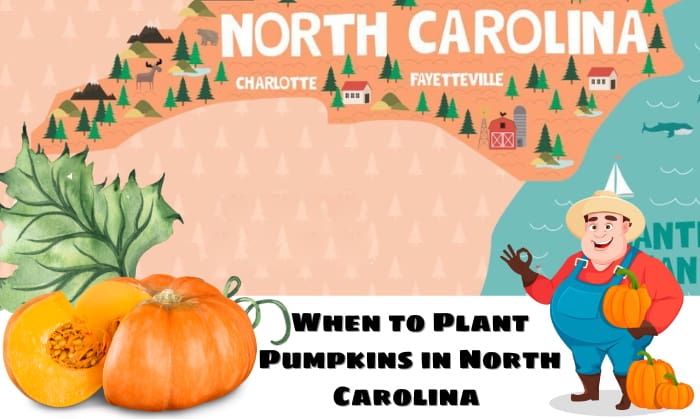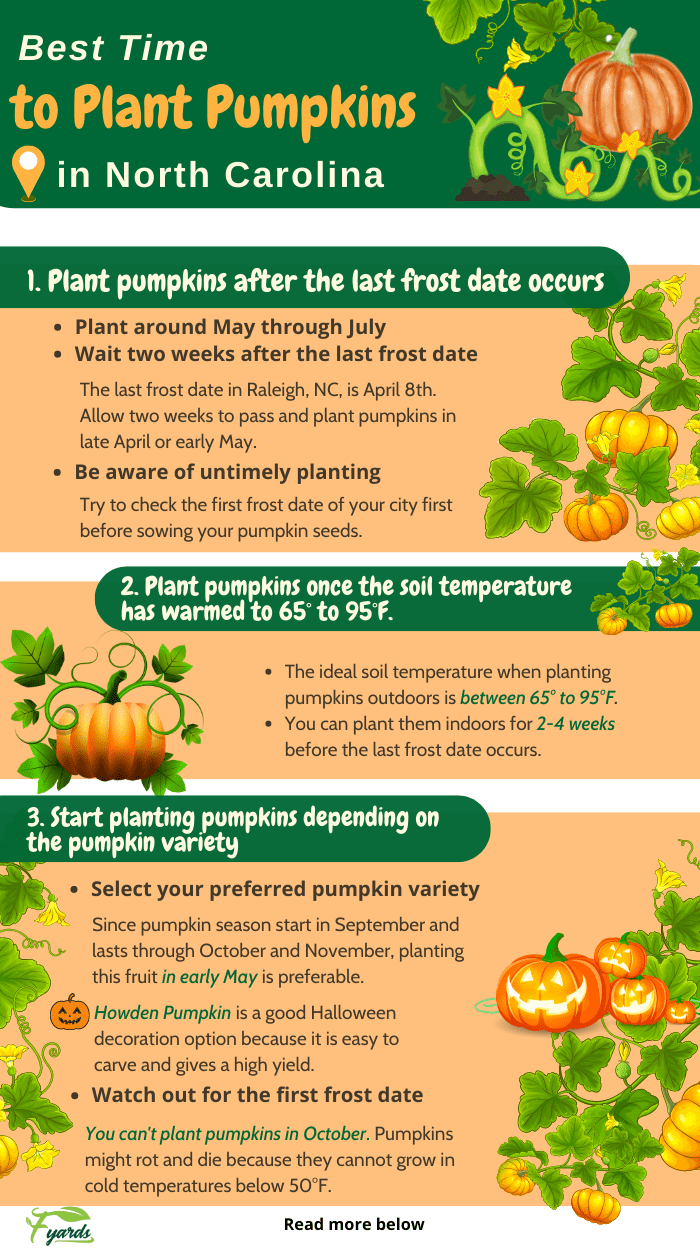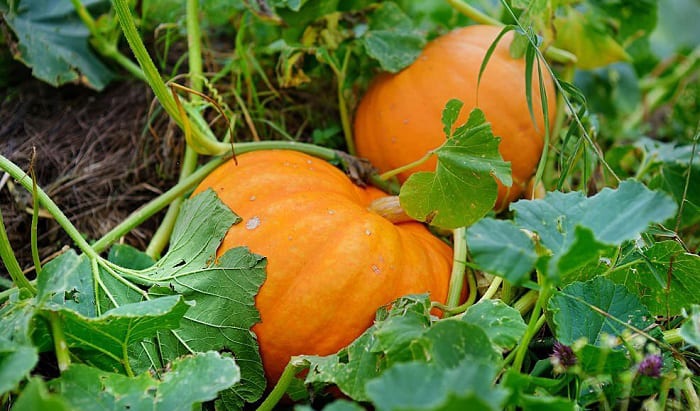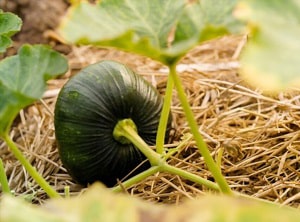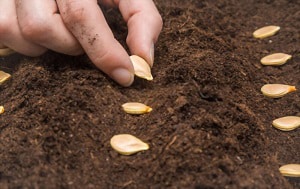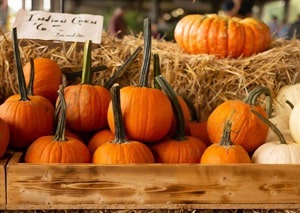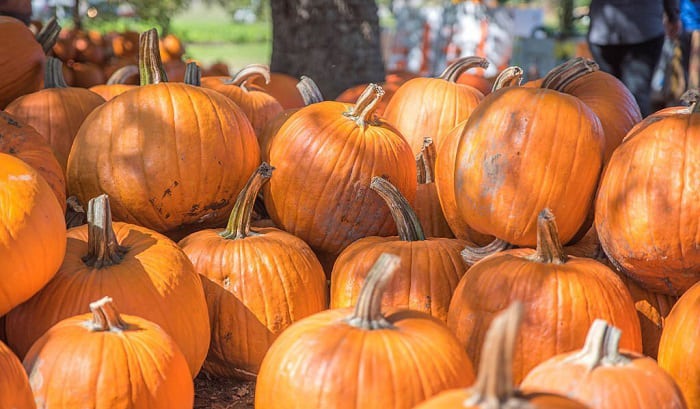The pumpkin has always been one of the popular festive fruits people use for autumn events. No wonder farmers in the North Carolina Mountains have been selling this agricultural product for over 20 years.
Learning when to plant pumpkins in North Carolina not only helps us harvest them on time, but we can also earn money from selling them for autumn. Wise, isn’t it?
In general, planting pumpkins after the last frost occurs, at a soil temperature of 65° to 95°F, and after deciding what variety you will grow, can help you have a timely harvest.
Table of Contents
Best Time to Plant Pumpkins in North Carolina
1. Plant pumpkins after the last frost date occurs.
Finding out the last frost date in your city is a key thing to do when planning to plant pumpkins in NC.
Pumpkins won’t develop well in the cold season, so growing them after the last frost dates have passed and when the weather has finally warmed is the smart thing to do.
- Plant around May through July.
The last frost month in the cities of North Carolina is usually April, so planting pumpkins outdoors usually starts in May through July.
For example, Charlotte in NC has its last frost date on April 11th (It’s suitable time to plant tomatoes), so growing this fruit around early May is ideal.
- Wait two weeks after the last frost date.
One tip when starting seeds directly into the soil outdoors is to wait for a maximum of 2 weeks after the last frost date has passed. Doing so ensures there will be no extended wintry days.
For example, the last frost date in Raleigh, NC, is April 8th. Allow two weeks to pass and plant pumpkins in late April or early May.
- Be aware of untimely planting.
Planting pumpkins in an untimely manner might cause danger to them.
When you grow pumpkins too early, their cells may be destroyed, and when they’re planted too late, the risk of not bearing fruit is possible.
So, try to check the first frost date of your city first before sowing your pumpkin seeds.
2. Plant pumpkins once the soil temperature has warmed to 65° to 95°F.
The ideal soil temperature when planting pumpkins outdoors is between 65° to 95°F.
When the soil is quite warm, these fruits grow fast and will guarantee a high yield once the harvest season comes.
When starting seeds, you can plant them indoors for 2-4 weeks before the last frost date occurs to avoid exposing the pumpkin seeds to extreme cold.
You can sow your seeds indoors by putting them in a pot and using artificial light.
3. Start planting pumpkins depending on the pumpkin variety.
- Select your preferred pumpkin variety.
Selecting the pumpkin variety is one of the main things to consider when scheduling a timely harvest.
Pumpkins usually need 85-120 days to grow.
Since pumpkin season start in September and lasts through October and November, planting this fruit in early May is preferable, so you can harvest it before pumpkins come in season.
For example, Howden Pumpkin is a good Halloween decoration option because it is easy to carve and gives a high yield.
This type of pumpkin needs 115 days to mature, so if you want to harvest it by October, June is the best time to grow it.
- Watch out for the first frost date.
Can you plant pumpkins in October? Sadly, you can’t.
Why? Because most of the first frost dates in the cities of North Carolina start around October, which is when the cold season begins again.
Pumpkins might rot and die because they cannot grow in cold temperatures below 50°F.
For example, the first frost date in Greensboro in NC is October 31st. Planting the seeds around this time may cause them harm, if they even survive the cold.
How to Plant Pumpkins in North Carolina?
After knowing when to plant pumpkins, it’s necessary to learn how to cultivate them in North Carolina. Follow this guide for a successful planting:
- Prepare well-draining soil. Well-drained soil is what pumpkins need, as it absorbs water quickly and doesn’t retain excess moisture.
- Make hills in the ground filled with composts like eggshells, coffee grounds, or paper pounded 12-15 inches deep to keep the soil quality high.
- Distance your hills by 4-8 ft. apart.
- Plant four seeds per hill by burying them an inch deep in the soil.
- Look for the seedlings that are stronger than others and pull the weaker ones once they reach a height of 2-3 inches.
Tips for Growing Pumpkins in North Carolina
- Avoid watering the pumpkin leaves, as they will rot and attract pests like squash bugs.
- Water the stem and soil on a day-to-day basis since pumpkins love water a lot.
- Surround the main stem with mulch such as wood chips, straw, and peat moss. Mulching around the stem will help maintain moisture in soil and vines, and can help spread nutrients.
- Once pumpkins sprout, trim the new vine’s edges to encourage only the growth of the present fruit.
How Late Can You Plant Pumpkins?
You can plant pumpkins anytime in summer as long as the variety you are planting can reach its maturity before the first frost date in your city occurs.
For example, Durham in NC has its first frost date on October 29th. Planting a Kentucky Field Pumpkin with 113 days to mature around August is too late.
It will either not survive because of coldness or will bear no fruit. So plant your pumpkin seeds before the cold climate comes.
Conclusion
There are three factors to consider when choosing the best time to grow pumpkins.
Not only does a warm climate and temperature matter, but your preference for the pumpkin variety also plays a key role in determining when to plant pumpkins in North Carolina. Along with that, finding out the first frost date in your city can save you from untimely planting and harvesting.
Furthermore, there are articles about vegetable planting calendars in other locations that you may be interested in, such as:
- Best time to plant pumpkins in Texas
- Suitable time to plant a vegetable garden in Michigan
Hopefully, you’ll be able to put these tips into use once the next growing season comes. Thank you for reading!

Hi, I am William – Floridayards’ digital content creator. My job is to find answers to all your concerns with thorough research and our team’s expert advice. I will also bring you honest reviews on the best products and equipment for raising your beautiful garden. Please look forward to our work!


